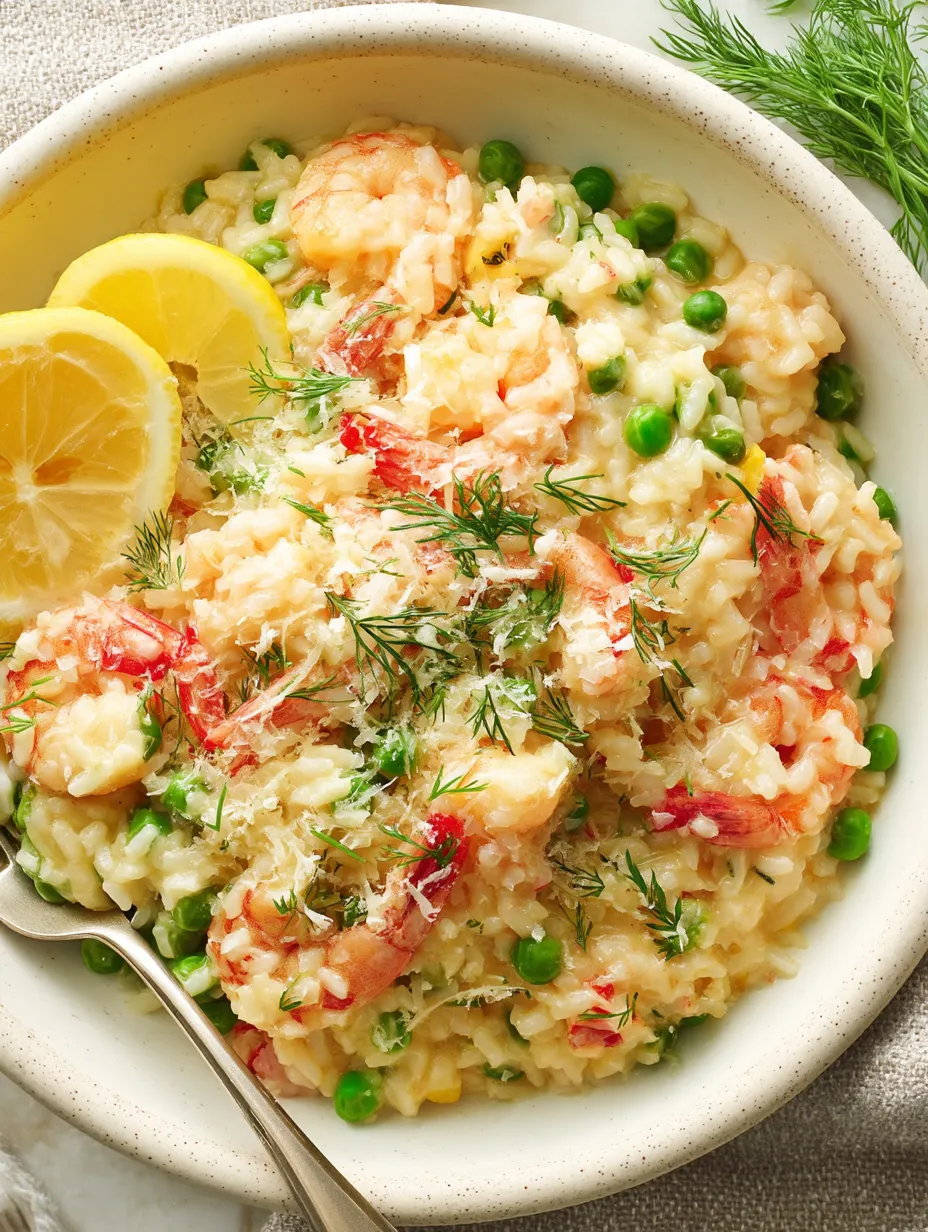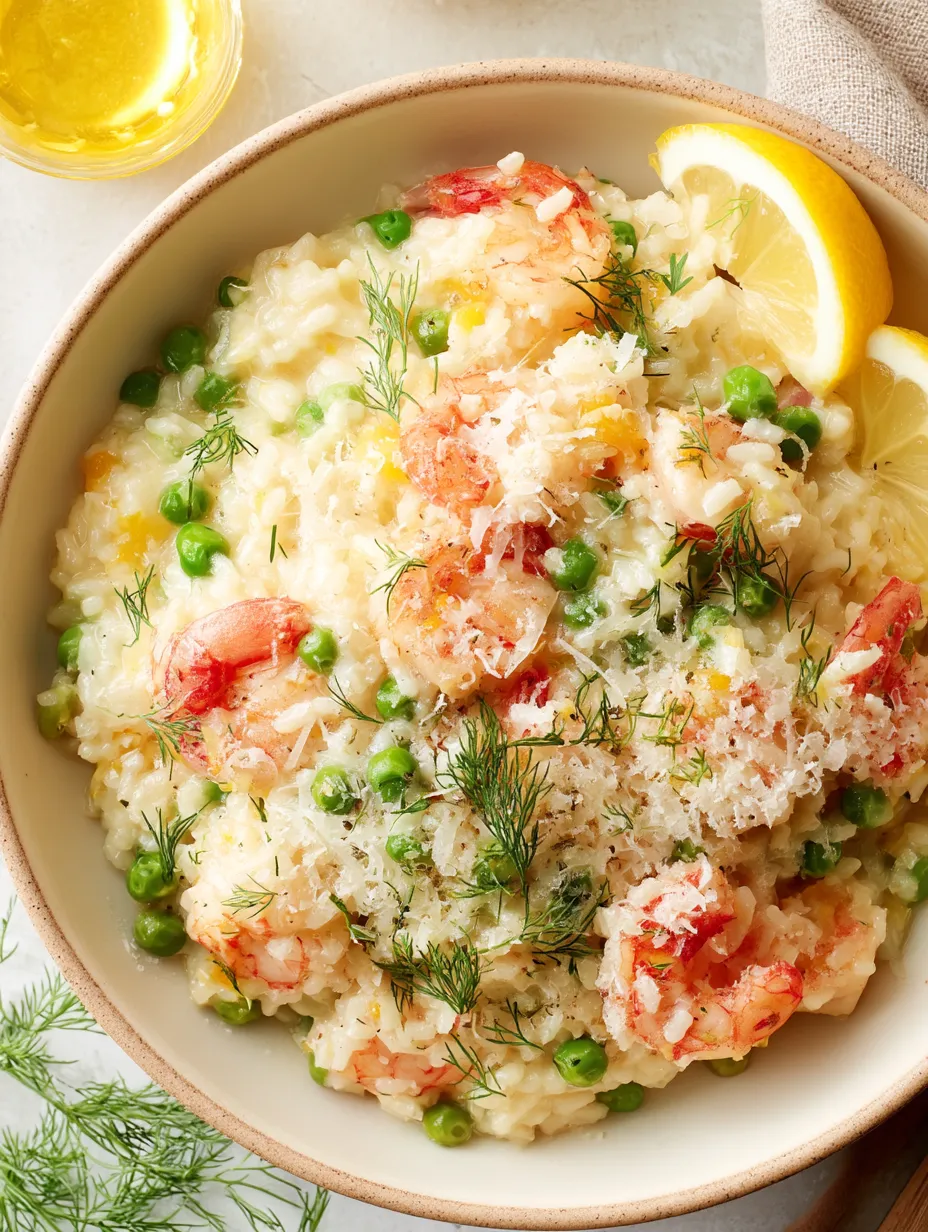 Pin it
Pin it
This colorful shrimp risotto gets its wonderful aroma from fennel, garlic, and lemon. It's an elegant dish that's quick enough to pull together on a weeknight yet impressive enough for special occasions. The combination of plump shrimp, sweet peas, and creamy rice creates a restaurant-quality meal that always feels like a treat.
I first made this risotto during a rainy weekend when I was craving comfort food with a touch of elegance. The rhythmic stirring became my meditation, and the fragrant combination of fennel and lemon filled my kitchen with the most incredible aroma. Now it's my go-to impressive dish when friends come over.
Ingredients
- Fish or seafood stock: this forms the foundation of flavor for the entire dish and infuses the rice with rich seafood essence
- Butter and olive oil: the combination gives you the perfect balance of rich flavor and proper cooking temperature
- Shallot: provides a milder sweeter onion flavor that complements seafood beautifully
- Garlic: adds essential aromatic depth without overpowering the delicate shrimp
- Crushed fennel seeds: these bring a subtle anise flavor that pairs perfectly with seafood
- Risotto rice: Arborio Carnaroli or Vialone Nano varieties have the perfect starch content for creamy risotto
- Dry white wine: adds brightness and acidity while helping to release the starchy creaminess
- Frozen or fresh peas: provide sweet pops of color and texture against the creamy rice
- Cooked small shrimp: the star protein that adds sweet briny flavor and tender texture
- Pecorino Romano cheese: adds salty richness and helps create the signature creamy texture
- Lemon zest and juice: brightens everything with essential acidity and freshness
- Fresh dill: for serving adds a final herbaceous note that enhances the seafood flavors
Step-by-Step Instructions
- Prepare The Stock:
- Heat your fish or seafood stock in a small saucepan until it reaches a gentle simmer then reduce the heat to low to keep it warm throughout the cooking process. Using hot stock is crucial as adding cold liquid would halt the cooking process each time.
- Create The Flavor Base:
- Melt butter with olive oil in a large sauté pan or cast-iron braiser over medium-low heat. Add the minced shallot and cook for 3 to 4 minutes stirring occasionally until they become translucent and soft but not browned. This gentle cooking releases the sweet flavor without bitterness.
- Toast The Rice:
- Add minced garlic crushed fennel seeds and risotto rice to the pan stirring continuously for 2 full minutes. You'll notice the rice grains becoming translucent around the edges while the center remains opaque. This toasting step is essential for developing depth of flavor and ensuring the rice cooks evenly.
- Deglaze With Wine:
- Pour in the white wine and stir vigorously as it bubbles up using your spoon to scrape up any flavorful caramelized bits from the bottom of the pan. Continue stirring until the wine is completely absorbed into the rice. The alcohol will cook off leaving behind a wonderful depth of flavor.
- Begin The Gradual Stock Addition:
- Add your first ladleful of warm stock to the pan stirring occasionally until the liquid is almost completely absorbed. You'll know it's time for more stock when you can drag your spoon through the rice and it leaves a clear path for a moment before flowing back together.
- Continue The Risotto Method:
- Keep adding stock one ladleful at a time allowing each addition to be absorbed before adding the next. This slow process takes patience but rewards you with perfectly cooked rice and the signature creamy texture. When about 1 cup of stock remains it's time for the next step.
- Add The Peas:
- Stir in the peas whether fresh or thawed frozen along with another half cup of stock. The peas will cook quickly in the hot risotto retaining their bright color and slight bite which provides wonderful textural contrast.
- Enrich The Texture:
- Add the grated Pecorino Romano cheese stirring until completely melted and incorporated. The cheese adds richness salinity and contributes significantly to that luxurious creamy texture risotto is known for.
- Finish With Brightness:
- Stir in the cooked shrimp lemon zest and juice along with freshly ground black pepper. The residual heat will warm the shrimp through while the lemon adds essential brightness that balances the rich creamy rice. Add salt only if needed as the cheese and stock provide significant seasoning.
- Final Touch:
- Pour in the remaining stock and stir to create the perfect consistency. The risotto should flow gently when tilted in the pan not stiff or stuck together. Cover and turn off the heat allowing it to rest briefly while you prepare to serve.
 Pin it
Pin it
The fennel seeds are my secret weapon in this recipe. I discovered their affinity for seafood during a cooking class in Venice where the instructor insisted on crushing them by hand rather than using pre-ground to release their aromatic oils. That small detail makes all the difference in creating the authentic Italian flavor profile that makes this dish so special.
The Art of Proper Risotto Texture
Achieving the perfect risotto consistency requires attention to detail. When properly cooked risotto should flow like lava not stand up like mashed potatoes. Italians call this ideal state "all'onda" meaning "wavelike." The finished dish should slowly spread when served in a warm bowl rather than holding a firm shape. If your risotto becomes too thick simply stir in a little more warm stock or even water just before serving. Remember that risotto continues to absorb liquid as it sits so serve it promptly for the best experience.
Make Ahead and Storage Tips
Risotto is famously best served immediately after cooking as it continues to absorb liquid and can become gummy when left to sit too long. If you need to prepare components ahead of time consider measuring and prepping all ingredients including warming the stock but wait to begin the actual cooking until shortly before serving. For leftovers refrigerate in an airtight container for up to two days. When reheating add a splash of warm stock or water to loosen the texture and gently warm over medium-low heat stirring frequently. The texture won't be quite as perfect as freshly made but the flavor will still be delicious.
Seasonal Variations
This versatile risotto template welcomes seasonal adaptations throughout the year. In spring replace the peas with asparagus tips or tender fava beans. Summer offers the opportunity to add cherry tomatoes or sweet corn kernels. Fall brings possibilities like diced butternut squash or wild mushrooms. You can also vary the protein swapping the shrimp for scallops clams or even lobster for special occasions. The key is maintaining the proper liquid to rice ratio and cooking technique while allowing the seasons to inspire your ingredients.
 Pin it
Pin it
Frequently Asked Questions
- → What type of rice works best for risotto?
Arborio, Carnaroli, or Vialone Nano rice are excellent choices for risotto because they are starchy and create the creamy texture you want.
- → Can I use frozen shrimp instead of fresh?
Yes, frozen shrimp works well. Ensure it is thawed completely and patted dry before adding it to the dish for the best texture.
- → What is the best way to reheat leftover risotto?
Place the leftover risotto in a nonstick skillet, add a couple of tablespoons of broth or water, and heat over medium-low heat until hot and creamy.
- → Can I substitute Pecorino Romano with another cheese?
You can substitute Pecorino Romano with Parmesan cheese. It will provide a similar nutty, salty flavor to the dish.
- → How do I prevent risotto from becoming dry?
Serve the risotto as soon as it is done cooking. If it sits too long, it can firm up. Add a splash of broth or water to loosen it before serving if needed.
